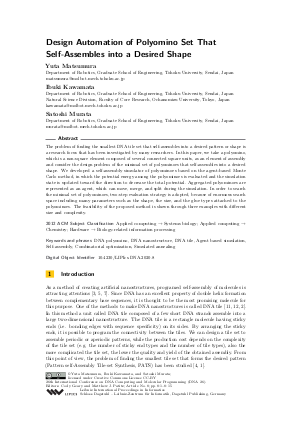Design Automation of Polyomino Set That Self-Assembles into a Desired Shape
Authors Yuta Matsumura, Ibuki Kawamata, Satoshi Murata
-
Part of:
Volume:
26th International Conference on DNA Computing and Molecular Programming (DNA 26)
Part of: Series: Leibniz International Proceedings in Informatics (LIPIcs)
Part of: Conference: International Conference on DNA Computing and Molecular Programming - License:
 Creative Commons Attribution 3.0 Unported license
Creative Commons Attribution 3.0 Unported license
- Publication Date: 2020-09-04
File

PDF
LIPIcs.DNA.2020.8.pdf
- Filesize: 1.53 MB
- 15 pages
Document Identifiers
Subject Classification
ACM Subject Classification
- Applied computing → Systems biology
- Applied computing → Chemistry
- Hardware → Biology-related information processing
Keywords
- DNA polyomino
- DNA nanostructure
- DNA tile
- Agent based simulation
- Self-assembly
- Combinatorial optimization
- Simulated annealing
Metrics
- Access Statistics
-
Total Accesses (updated on a weekly basis)
0Document
0Metadata
Abstract
The problem of finding the smallest DNA tile set that self-assembles into a desired pattern or shape is a research focus that has been investigated by many researchers. In this paper, we take a polyomino, which is a non-square element composed of several connected square units, as an element of assembly and consider the design problem of the minimal set of polyominoes that self-assembles into a desired shape. We developed a self-assembly simulator of polyominoes based on the agent-based Monte Carlo method, in which the potential energy among the polyominoes is evaluated and the simulation state is updated toward the direction to decrease the total potential. Aggregated polyominoes are represented as an agent, which can move, merge, and split during the simulation. In order to search the minimal set of polyominoes, two-step evaluation strategy is adopted, because of enormous search space including many parameters such as the shape, the size, and the glue types attached to the polyominoes. The feasibility of the proposed method is shown through three examples with different size and complexity.
Cite As Get BibTex
Yuta Matsumura, Ibuki Kawamata, and Satoshi Murata. Design Automation of Polyomino Set That Self-Assembles into a Desired Shape. In 26th International Conference on DNA Computing and Molecular Programming (DNA 26). Leibniz International Proceedings in Informatics (LIPIcs), Volume 174, pp. 8:1-8:15, Schloss Dagstuhl – Leibniz-Zentrum für Informatik (2020)
https://doi.org/10.4230/LIPIcs.DNA.2020.8
BibTex
@InProceedings{matsumura_et_al:LIPIcs.DNA.2020.8,
author = {Matsumura, Yuta and Kawamata, Ibuki and Murata, Satoshi},
title = {{Design Automation of Polyomino Set That Self-Assembles into a Desired Shape}},
booktitle = {26th International Conference on DNA Computing and Molecular Programming (DNA 26)},
pages = {8:1--8:15},
series = {Leibniz International Proceedings in Informatics (LIPIcs)},
ISBN = {978-3-95977-163-4},
ISSN = {1868-8969},
year = {2020},
volume = {174},
editor = {Geary, Cody and Patitz, Matthew J.},
publisher = {Schloss Dagstuhl -- Leibniz-Zentrum f{\"u}r Informatik},
address = {Dagstuhl, Germany},
URL = {https://drops.dagstuhl.de/entities/document/10.4230/LIPIcs.DNA.2020.8},
URN = {urn:nbn:de:0030-drops-129614},
doi = {10.4230/LIPIcs.DNA.2020.8},
annote = {Keywords: DNA polyomino, DNA nanostructure, DNA tile, Agent based simulation, Self-assembly, Combinatorial optimization, Simulated annealing}
}
Author Details
- Department of Robotics, Graduate School of Engineering, Tohoku University, Sendai, Japan
- Department of Robotics, Graduate School of Engineering, Tohoku University, Sendai, Japan
- Natural Science Division, Faculty of Core Research, Ochanomizu University, Tokyo, Japan
References
- Mika Göös and Pekka Orponen. Synthesizing minimal tile sets for patterned dna self-assembly. In International Workshop on DNA-Based Computers, pages 71-82. Springer, 2010. URL: https://doi.org/10.1007/978-3-642-18305-8_7.
- Yu He, Yi Chen, Haipeng Liu, Alexander E Ribbe, and Chengde Mao. Self-assembly of hexagonal dna two-dimensional (2d) arrays. Journal of the American Chemical Society, 127(35):12202-12203, 2005. URL: https://doi.org/10.1021/ja0541938.
- Chenxiang Lin, Yan Liu, Sherri Rinker, and Hao Yan. Dna tile based self-assembly: building complex nanoarchitectures. ChemPhysChem, 7(8):1641-1647, 2006. URL: https://doi.org/10.1002/cphc.200600260.
- Xiaojun Ma and Fabrizio Lombardi. Synthesis of tile sets for dna self-assembly. IEEE Transactions on Computer-Aided Design of Integrated Circuits and Systems, 27(5):963-967, 2008. URL: https://doi.org/10.1109/tcad.2008.917973.
- Sung Ha Park, Robert Barish, Hanying Li, John H Reif, Gleb Finkelstein, Hao Yan, and Thomas H LaBean. Three-helix bundle dna tiles self-assemble into 2d lattice or 1d templates for silver nanowires. Nano letters, 5(4):693-696, 2005. URL: https://doi.org/10.1021/nl050108i.
- Matthew J Patitz. An introduction to tile-based self-assembly and a survey of recent results. Natural Computing, 13(2):195-224, 2014. URL: https://link.springer.com/content/pdf/10.1007/s11047-013-9379-4.pdf.
- Paul WK Rothemund. Folding dna to create nanoscale shapes and patterns. Nature, 440(7082):297-302, 2006. URL: https://doi.org/10.1038/nature04586.
- Alessandro Troisi, Vance Wong, and Mark A Ratner. An agent-based approach for modeling molecular self-organization. Proceedings of the National Academy of Sciences, 102(2):255-260, 2005. URL: https://doi.org/10.1073/pnas.0408308102.
- Erik Winfree. Simulations of computing by self-assembly. In Fourth International Meeting on DNA-Based Computing. California Institute of Technology, 1998. URL: https://doi.org/10.7907/Z9TB14X7.
- Erik Winfree and Renat Bekbolatov. Proofreading tile sets: Error correction for algorithmic self-assembly. In International Workshop on DNA-Based Computers, pages 126-144. Springer, 2003. URL: https://doi.org/10.1007/978-3-540-24628-2_13.
- Erik Winfree, Furong Liu, Lisa A Wenzler, and Nadrian C Seeman. Design and self-assembly of two-dimensional dna crystals. Nature, 394(6693):539-544, 1998. URL: https://doi.org/10.1038/28998.
- Hao Yan, Sung Ha Park, Gleb Finkelstein, John H Reif, and Thomas H LaBean. Dna-templated self-assembly of protein arrays and highly conductive nanowires. science, 301(5641):1882-1884, 2003. URL: https://doi.org/10.1126/science.1089389.
